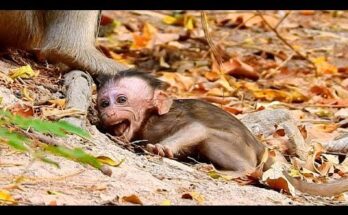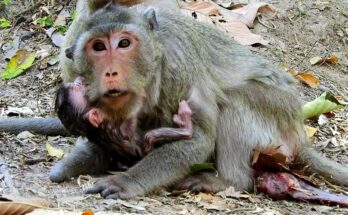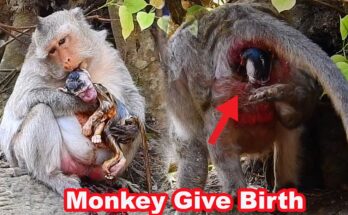In the quiet corner of the monkey troop’s territory, an unusual scene began to draw the attention of anyone watching closely. Dolly, a medium-sized female monkey known for her strong will and sometimes unpredictable behavior, was interacting with little Brutus Jr in a way that puzzled many. Brutus Jr, still a young and curious monkey, was not yet fully accustomed to the more complex social behaviors of his troop. What Dolly was doing to him seemed to blend elements of care, dominance, and perhaps even playful mischief — but the true reason behind her actions was not immediately clear.
At first glance, Dolly’s approach appeared gentle. She came near Brutus Jr slowly, grooming his fur, picking away tiny bits of dirt and insects with careful precision. In monkey society, grooming is more than just hygiene — it’s a way of bonding, showing affection, or asserting social ties. Brutus Jr seemed relaxed in these first moments, enjoying the attention. However, it wasn’t long before Dolly’s behavior shifted. She began to tug lightly on his arms and legs, pulling him closer and holding him in a way that suggested she wanted to control his movements.
Observers noticed that Brutus Jr’s demeanor changed. His once-relaxed posture became tense, his eyes darting around as if looking for a way out. Dolly, however, kept her grip, sometimes repositioning him, sometimes nudging him to follow her. This sudden shift left many wondering — was Dolly trying to protect Brutus Jr from something, or was she asserting dominance over a younger member of the troop?
In the wild, older females sometimes take a keen interest in younger monkeys, especially if they feel the youngster needs guidance or discipline. It’s also possible Dolly was imitating a motherly role, even if she wasn’t Brutus Jr’s actual mother. Yet, there were moments when her behavior crossed into more assertive territory — blocking his path, pulling him when he hesitated, and even making low vocalizations that could be interpreted as warnings or commands.
Another theory among onlookers was that Dolly’s behavior stemmed from social rivalry. Perhaps she wanted to show other troop members that she could “control” Brutus Jr, marking her influence within the group’s hierarchy. For a young monkey like Brutus Jr, this was a delicate situation — resisting too much could lead to trouble, while submitting could mean giving up some of his independence.
Throughout the interaction, Brutus Jr alternated between passive compliance and small attempts to wriggle free. Each time he tried to step away, Dolly would reach out, pulling him back or guiding him in a new direction. It was as if she had a specific purpose in mind, but whether that purpose was protection, teaching, or dominance remained unclear.
By the time Dolly finally released him, Brutus Jr scampered off to a safer spot, glancing back only once. The air of mystery lingered — why was Dolly so intent on doing what she did to him? In the intricate social world of monkeys, such moments are rarely random. Whether it was an act of care, control, or subtle rivalry, one thing was certain: Dolly had made her point, and Brutus Jr would not soon forget the encounter.


